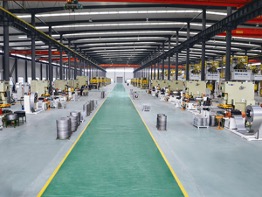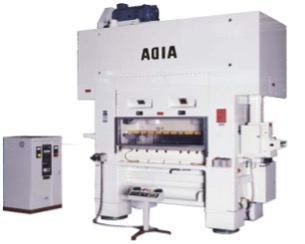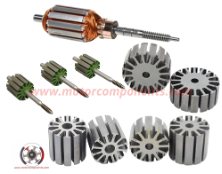
Table of Contents:
- Motor Laminations Overview
- Production Process
- Production Capabilities
- Comparison of Motor Lamination Stamping Solutions
- Material Options
- Specifications
- Applications
- Conclusion
Motor Laminations Overview
Motor laminations are crucial components in electric motors, facilitating the conversion of electric energy into mechanical power through electromagnetic interaction. They form the core of transformers or electric motor components.
Production Process
Motor laminations, also known as electrical laminations, are profiled from electrical steels and stacked, then bonded together to form the core of transformers or electric motor components. Advanced die-making technology enables the production of various lamination types for different motor applications.
Production Capabilities
 Our production capabilities include:
Our production capabilities include:
- Fully integrated and tooled-up high-speed press lines ranging from 60 to 450 tons.
- Two-point mid/low-speed large format stamping press lines.
- World-class progressive and compound lamination stamping tools designed for high-speed stamping up to 800spm.
| Description | STAMPINGS, MOTOR LAMINATIONS |
| STAMPING TYPES | · Armature laminations · Rotor Laminations · Stator Laminations · Notched Laminations · Welded Laminations · Segmented Stator Laminations · Custom laminations · Interlocked laminations · Buckle & rivet bonded laminations · Screw bolted laminations · Die-cast rotors & Stators (Aluminium/copper) · Loose laminations · Bonded laminations · Laser or wire cut laminations · Wound stators & rotors · Transformer Laminations |
| Materials | · CRML- Cold Rolled Motor Lamination Steel · NGO- Non-Grain Oriented Steel · GO – Grain Oriented Steel · Silicon steel · Nickel alloys · Cobalt alloys |
| Thickness | 0,20 – 0,30 – 0,35 – 0,50 – 0,65 mm |
| Stamping size | From OD 4mm- up to 1250mm |
| Workpiece Tolerance | ± 0.005mm, |
| Die tolerance | 0.001-0.003 mm |
| Die life | 150-200 million strokes |
| Certifications | ISO 9001 / TS16949 |
| Standards | ASTM, AISI, BS, DIN, JIS, NF |
| Production | Low to high volume production |
| Tooling | Most tooling is designed & manufactured by us with our core expertise and Tool Modelling, Tool Path Generation, VMC Machining, EDM Processes, and other related activities, which are done in house to cut down & maintain development times at the lowest. We take responsibility for proving the components of the dies made by us. |
| Process | Tooling, slitting, progressive stamping, CNC machining, blanking, notching, grinding, milling, boring, drilling, shearing, deburring, cutting, casting, welding, laser cutting, surface treatment, ultrasonic cleaning, inspection, etc. |
| Secondary operations | · Annealing · Stress Relief Annealing · Cleating /stacking and welding. · Punching · Bonding · Pressing · Electrostatic Epoxy Coating · Die casting · Machining · Grinding · Winding |
| Surface treatments | Electrostatic Epoxy Coating, (B, F & H Class) painting, polishing, brushings, plating ( zinc, nickel, chrome, silver, titanium) powder coating, anodizing, electrophoretic coating, PVD, as per requirement. |
| Heat Treatments | Induction hardening, normalization, stress relive annealing, quenching, tempering, case Hardening, nitriding, etc. |
| Samples | We offer lamination in Loose, riveted, skewed, bonded, welded, punched-packed. Laser-cut or wire-erosion special sheets for sample production, prototype, and pilot series. |
| Applications | Automotive, home appliances, power tools, industrial motors and pumps, marine, aerospace, EV, other electrical machinery applications |
PRODUCTION MACHINERY
 Processing equipments | · Servo Stamping presses · Hydraulic presses · CNC machining centre · CNC Grinding machines · Punching machines · CNC laser cutting machines · WEDM Machines · CNC Milling machines · CNC Bending machines · CNC welding machines · Drilling & boring machines · Cutting and Shearing machines · Bevelling machine · Riveting machines · Casting machines · Heat treatment furnace/equipment · Nitriding equipment · Cleaning equipment · Testing and Inspection equipment etc… |
| Inspections | · CMM (Coordinate Measuring Machine) · Vision System · Digital tool microscope · Iron Loss Tester, Epstein Tester · Overhead projectors · Optical System · Surface roughness measuring instrument · Optical Comparator · Run-out instrument · Gauging instruments; for thread, height, roundness · Micrometres · Die-cast Rotor test instrument · Rockwell/Vickers Hardness Tester · Tensile test machine · Interlock Pull strength Checking Instrument · Stator Winding Surge Tester, HV, Resistance Tester · Coat Gauge, Pin Gauge · Bore Scope · Bore Gauges · Custom Gauging · Gage Calibration System |
Comparison of Motor Lamination Stamping Solutions

| Capability | Advantage |
|---|---|
| Low Tooling Cost | Cost-effective production solutions, minimizing upfront expenses for manufacturers. |
| Quick Turnaround | Rapid response times from design to production, enabling faster time to market for products. |
| Engineering Assistance | Expert support in optimizing designs and materials for specific motor requirements. |
| Fast Quote Response | Efficient quoting process, facilitating streamlined communication and decision-making. |
| In-House Tool Design | Comprehensive control over tooling design and manufacturing processes, ensuring quality and customization. |
TOOLING OPTIONS
Most tooling is designed & manufactured by us with our core expertise and Tool Modelling, Tool Path Generation, VMC Machining, EDM Processes, and other related activities, which are done in house to cut down & maintain development times at the lowest. We take responsibility for proving the components of the dies made by us and we maintain the tooling at no extra cost for it s life.
Short run and prototype requirements can be produced by notch tooling, wire EDM or laser cut. The tooling cost is low but the piece part price is significantly higher.
Intermediate tooling for quantities of up to five million can be designed using our proprietary extensive Master Die Insert Program, which offers all the advantages of a full production tool but at a much lower cost.
For higher production volumes, Carbide Progressive Tooling is available with guarantees to 100 million parts, which offers all the advantages of a full production tool but at a much lower cost.
We can design, manufacture singled, doubled and tripled row interlocked / skew / Indexed, buckle bonded, rivet bonded, stamping tool as per customer requirements.
Carbide Progressive stamping Dies:
Ideal for high volume requirements. The cost of the stamping tool is high, but the unit price per piece of stator and rotor core becomes more economical.
Progressive stamping die can be used to stamp loose sheets or auto-stacked cores.
We can also build a skewing mechanism for the rotor or 180-degree indexing feature for the stator.
We design the die for stamping stator and rotor core, outsource die parts for fabrication, then assemble the progressive stamping die in the house.
Currently, the thinnest material we can stamp with a progressive stamping die is 0.2mm.
The quality: tolerance of spare parts is within 0.002mm, tolerance of feeding length is within 0.003-0.005mm, and roughness is within ra 0.04-0.1.
Efficiency: stamping speed reaches 300-1200 strokes per minute (depend on product type)
durability: single shot die life 200-600 million times (according to the material and set), a comprehensive life 1.2-2.5 million times.
TYPE OF DIES:
· Index die
Dies performing automated stacking through the rotation of each lamination at a fixed angle (30°, 45°, 60°, 90°) while performing core stacking
(improve concentricity and thickness deviation of stack height)
· Index + Skew
Materialize the fixed angle and minute angle at the same time while performing core stacking
· Skew die
Dies performing automated stacking through the rotation of each core at a minute angle while performing core stacking (reduce motor noise)
· Wrap up core die
· Segment core die
- Compound Stamping Dies:
The ideal option for small quantity rotor-stator production.
The tooling cost is cheaper compared with progressive stamping die, but the labour cost is higher. Only loose sheets can be produced from a compound tool.
- Notching Dies
- Short-run stamping tool
- Progressive Staking Dies
- Laser-cut or wire erosion
Material Options
Motor laminations can be crafted from various materials, including CRML (Cold Rolled Motor Lamination) Steel, NGO (Non-Grain Oriented) Steel, GO (Grain Oriented) Steel, Silicon steel, Nickel alloys, and Cobalt alloys.
Specifications
Specifications that are possible to manufacture:
| Parameter | Range |
|---|---|
| Thickness | 0.20mm – 0.65mm |
| Stamping Size | OD 4mm – up to 1250mm |
| Workpiece Tolerance | ± 0.005mm |
| Die Tolerance | 0.001mm – 0.003mm |
| Die Life | 150-200 million strokes |
| Certifications | ISO 9001 / TS16949 |
| Standards | ASTM, AISI, BS, DIN, JIS, NF |
Applications
Motor laminations find applications across various industries, including automotive, home appliances, power tools, industrial motors, transformers, and electric vehicle (EV) industries.
Conclusion
Understanding the role of motor laminations in electric motors and their production capabilities is crucial for enhancing motor efficiency and performance across diverse applications. With advanced technology and a focus on quality, manufacturers can optimize motor designs to meet specific industry requirements effectively.